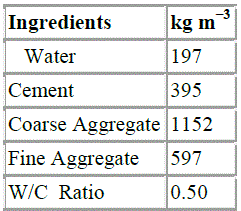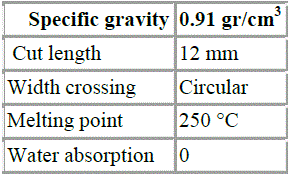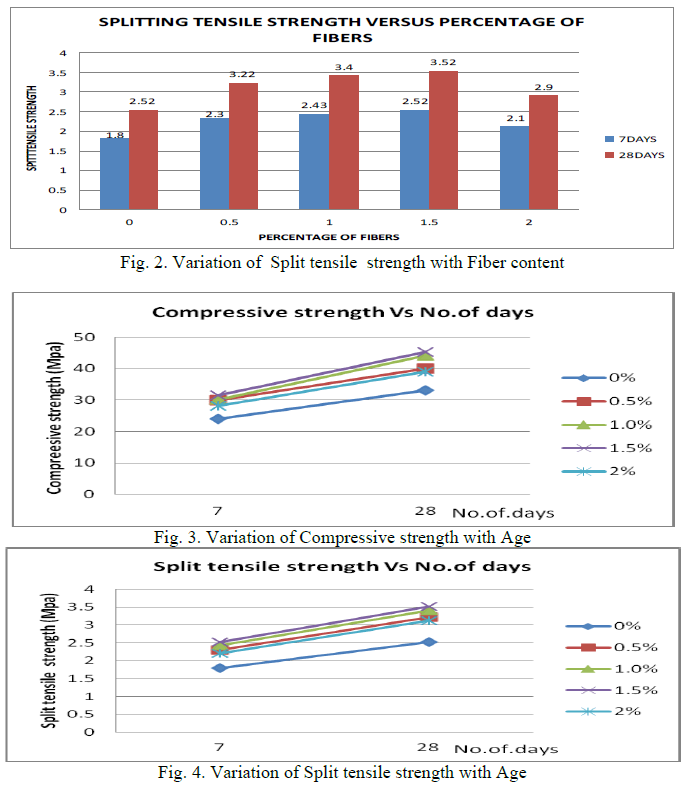ISSN ONLINE(2319-8753)PRINT(2347-6710)
ISSN ONLINE(2319-8753)PRINT(2347-6710)
| Kolli.Ramujee Associate Professor,Department of Civil Engineering, VNR Vignana jyothi Institute of Engineering & Technology, Hyderabad,Andhra Pradesh,India |
| Related article at Pubmed, Scholar Google |
Visit for more related articles at International Journal of Innovative Research in Science, Engineering and Technology
The interest in the use of fibers for the reinforcement of composites has increased during the last several years. A combination of high strength, stiffness and thermal resistance favorably characterizes the fiibers. In this study, the results of the Strength properties of Polypropylene fiber reinforced concrete have been presented. The compressive strength, splitting tensile strength of concrete samples made with different fibers amounts varies from 0%,0.5%,1% 1.5% and 2.0% were studied. The samples with added Polypropylene fibers of 1.5 % showed better results in comparison with the others.
Keywords |
| Concrete, Polypropylene fibers, Compressive Strength, Split Tensile strength. |
INTRODUCTION |
| In recent years, many studies have been conducted in the mechanical characteristics of reinforced fiber concrete. Such concrete is also used in retrofitting and repairing the covering of concrete structure, tunnels, etc. Polypropylene fibers (at relatively low volume fractions <0.3%) are used for: secondary temperature shrinkage reinforcement, overlays and pavements, slabs, flooring systems, crash barriers, precast pile shells and shotcrete for tunnel linings, canals and reservoirs [1].. According to the researches, the increase of formability and bending strength are the extra advantages of adding the fibers to the concrete. Two kinds of fiber that very often used in the concrete are: steel fiber and polypropylene fiber [2]. The evaporation of concrete surface water is a factor in creating the contract paste fracture in concrete which leads to the formation of tension stress since the concrete starts to strengthen [3]. Zeiml et al. [4] mentioned that using polypropylene fibers can improve spalling behavior of concrete. The paste fractures are formed when the acceleration of water evaporation is more than the movement of concrete emulsion to the surface. Here, the negative pressure is generated in the capillaries through which the concrete paste flows and proportionately the tension stress is formed. Such stress is developed during the concrete strengthening and the concrete is cracked where the stress is more than the concrete strength. The cracks caused by paste contracting in the concrete are formed in the first hours after pouring the concrete in the frames and before the concrete reaches its initial strength. Such cracks create critical points in the concrete sensitivity for attaching harmful materials to internal parts of concrete that finally can lead to corrosion and damaging the material in the concrete. Consequently, the performance, servicing or profiting capability, duration, aestheticism and strength of the concrete structures are reduced. Controlling the paste contract tracks in the concrete is of great importance in more duration and resistibility of concrete in the shortest time of structural utilization [4–5]. In ordinary concrete, where vibration is necessary, the best and most acceptable method for preventing cracks formations caused by paste contract is by using fibers, particularly thin artificial ones with the volume of less than 0.5% [6,7].Polypropylene fibers have hydrophobic levels, which protect them against wetting with cement paste. The hydrophobic nature of polypropylene has no effect on the amount of water needed for concrete . The characteristics of different fibers are listed in Table 1 [8] In this study the influence of different amount of polypropylene fibers content on concrete properties were investigated by measuring compressive strength and splitting Tensile strength. |
| Table I The characteristics of different fibers |
 |
II. EXPERIMENTAL DETAILS |
| Materials and mix proportion. Cement: The cement used was locally available 53 Grade of Make SUVARNA CEMENTS, Kodad, A.P . The cement has a specific gravity of 3.02 with initial and final setting times 50 and 170 minutes respectively. The compressive strength measured in standard mortar at 28 days was 54.0 MPa.The physical properties are confirming to IS: 12269-1987. Aggregates: Coarse Aggregates are Crushed angular granite metal from a local source was used . The Specific gravity was 2.70 , Bulk density of 1450 kg/m3 with void percentage 1.5 . The River sand was used as fine Aggregate and conforming to Zone:III with specific gravity of 2.6, Bulk density of 1680 kg/m3 . The physical properties are confirming to IS: 2368-1968. Water: To mix the ingradients of concrete Tap water has been used. Polypropylene fibers (PP): The fibres used were fine polypropylene monofilaments .The fibers were supplied by Reliance Industry by name RECRON 3s .It is available in 3 different sizes i.e 6mm,12mm and 24 mm .In the present investigation 12mm fiber length is used . Mix design:The Concrete mix design has been carried out for various proportions as per and arrived at final mix proportion (cohesive ) and mentioned in Table 2 was used for combining the initial materials., after mixing the initial materials in the rotating mixer and adding the fibers. In this research the concrete samples were prepared with fiber ratios of 0, 0.5 ,1.0, 1.5 and 2 % by volume. In order to have a proper mixture design as well as the least penetration, the applied aggregates were graded according to the . The ratio of water added to the cement was w/c = 0.50. |
 |
| Table II. The Raw materials used in the presented mixture design. |
 |
| Table III. Physical characteristics of. Polypropylene fibers |
| The cubes were cast in steel moulds of inner dimensions of 150x 150x 150mm and the cylinders with 150x 300mm height. Compression test and split tensile tests were performed on cube and cylinder respectively at uniform rate using the 2000 kN Compression Testing machine. |
III. RESULTS AND DISCUSSIONS |
| It is observed form the fig 1 that the cube compressive strength increased upto 1.5 % fiber content there after strength is decreased at 2.0% of fiber content. The cube compressive strength observed as 40.9 N/mm2 for 0.5% of fibers , 44.12 N/mm2 1% of fibers and 45.25 MPa for 1.5% fiber content in the concrete at 28 days. The compressive strength was decreased to 40.50 N/mm2 for 2% fiber content . There is a reduction in slump with increase in fiber content, especially beyond 1.5% dosage. However, The compressive strength for controlled mix at 28 days was observed as 33.70 N/mm2. It is observed from fig.2 that the Split tensile strength was increased upto 1.5 % fiber content there after strength is decreased at 2.0% of fiber content.The split tensile strength at 28 days observed as 3.22 N/mm2 for 0.5% of fibers , 3.4 N/mm2 1% of fibers and 3.52 N/mm2 for 1.5% fiber content in the concrete. However ,The split strength for controlled mix at 28 days was observed as 2.52 N/mm2. From the Experimental investigation carried out, it was observed that when fibers are used in concrete it enhances both the compressive and split tensile strength of concrete. This trend is observed with all percentages of fiber content 0.5-1.5% at all ages. the reduction of slump with increase in fiber observed and the mix becomes fibrous so a dosage rate of 1.5% would yield economical result. |
 |
| Fig1. Variation of Compressive strength with Fiber content |
 |
III. CONCLUSIONS |
| Based on the Experimental Investigations, the following conclusions were drawn. |
| (1) The Reduction of slump is noticed with increase in fiber content, especially beyond 1.5% dosage, the mix becomes fibrous which results in difficulty in handling. |
| (2) The Compressive strength and splitting tensile strength tests reveals that , the strengths were increased proportionately with the increase in volume ratios of Polypropylene Fibers with reference to the controlled mix without fibers. |
| (3) The maximum increase in Compressive strength was 34% and split tensile strength was 40% compared to the mix without fibers. |
| (4) The samples with fibers content of 1.5 % showed optimum results in Comparison with other samples in this study. |
References |
|